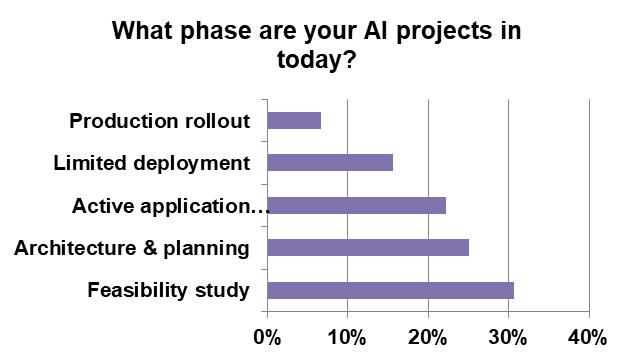
Without splitting a lot of hairs on definitions, it is safe to say that machine learning in its myriad forms is absolutely shaking up data processing. The techniques for training neural networks to chew through mountains of labeled data and make inferences against new data are set to transform every aspect of computation and automation. There is a mad dash to do something, as there always is at the beginning of every technology hype cycle.
Enterprises need to breathe. The hyperscalers are perfecting these technologies, which are changing fast, and by the time things settle out and the software stacks mature, then will be the time to act. That is the main idea that can be derived from a survey that OrionX.net has just performed.
OrionX.net recently conducted a comprehensive survey on artificial intelligence, deep learning, and machine learning. The survey was concluded in in the third quarter of last year and contained 161 different data points covering customer present and future AI efforts. The survey asked questions ranging from the tools that customers are using, to their current AI projects, including questions on their goals, problems, and spending plans on AI-related products and services.
In the next three articles, we are going to examine some of the data arising from this survey and look at the broad trends we’ve discovered through this survey. In this first article, we are going to examine how real-world customers are approaching AI/ML/DL today.
First, let’s take a quick look at the demographics of our respondents.
We had a total of 303 professionals take the survey between 2Q and 3Q 2017. Almost all of the respondents have some involvement with AI/ML/DL in their organizations, with more than 40 percent being involved on a full time basis.
Our survey respondents represented a wide range of industries, remarkably diverse. The largest category, Financial Services/Insurance only accounted for just over 12 percent of the respondent base. Manufacturing and Engineering, both in consumer and business products, were well represented with almost 12 percent and 11 percent respectively.
It Is Early, Very Early
If you read the industry press and breathless analyst whitepapers, you would think that the Age of AI was well underway and that anyone who doesn’t have an AI infrastructure is a hopeless laggard. While that might be a bit of an exaggeration, the industry hype and associated accounts of anecdotal miracles of AI are bound to make current AI-less organizations feel a little uncomfortable.
Don’t worry, there’s still plenty of time to get your AI act together. Only 7 percent of the users we surveyed have any sort of production AI system in place today. About 16 percent have some sort of limited deployment.
So less than a quarter of the organizations surveyed have AI applications that are working to some extent. This means that more than 75 percent are still developing their applications, architecting their solution, or just studying the feasibility of AI in their organizations.
It is interesting that most of our respondents rated their AI prowess as fairly low. As you can see in the graph, only 11 percent rated themselves in the top echelon when it comes to AI understanding. About the same number put themselves in the bottom ranking. More than half of the respondents said that their skills rated a modest “2” or “3” on our five point scale.
This, along with other data showing that organizations are planning to devote significantly more money to AI training, consulting, and hiring, shows us that AI expertise is at a premium and that most orgs are looking to build their internal knowledge bank and augment it with outside expertise if necessary.
One of the big misconceptions in the AI ‘industry’ that we’ve uncovered with this survey is that a large proportion of AI processing is based on images. In an upcoming article, we’re going to discuss what customers are actually doing (it’s much more text and numbers than images), but for now, take a look at the chart that shows practitioner familiarity with the most popular image recognition models.
Only 2 percent of our survey takers claimed expert status in any of the leading neural network AI models (Oxford VGG-16, Microsoft’s ResNet, Nvidia’s DetectNet). Just 10 percent of our survey based has actually used one of the models, and close to 10 percent are planning to use one of the models in their AI projects.
Keeping in mind that a large proportion of our respondents (more than 75 percent) say that they are significantly involved in their organizations AI efforts, why do 45 percent of them say that they are not familiar with the most popular image recognition neural networks? Answer: because the large majority of them aren’t doing image processing. Again, we will take a deeper look at this in our next article.
 While AI practitioners aren’t so sure of their skills (as we’ve seen above), it’s almost a dead heat when you ask them if they believe they have a good handle on what’s available in the market for AI hardware and software.
While AI practitioners aren’t so sure of their skills (as we’ve seen above), it’s almost a dead heat when you ask them if they believe they have a good handle on what’s available in the market for AI hardware and software.
We tend to think that a large percentage of the respondents who answered “it’s not that complicated” simply don’t have enough real world experience to realize just how complicated AI actually is. In other words, they don’t know what they don’t know yet. We’re going to ask this question on our next edition of this survey, so it will be interesting to see how the answers vary once respondents have another year of AI under their belt.
On The Job Training, Not Off The Rack AI
It looks like most customers will be learning through building out their own AI projects. Looking at the chart below, there’s a lot of work ahead of these organization, with only 27 percent would implement a turnkey solution if one were available. The rest are either going to modify existing applications or even write their own applications from scratch, if necessary.
This result points to the perceived importance of AI for organizations. Companies obviously see AI as a source of significant competitive advantage. We also believe that they see AI as something so important that they can’t take a cookie cutter approach to it. They need to take a custom approach in order to get the most return on their investment.
In the survey, we have learned that AI is still an infant – not even a toddler yet. Very few organizations in the real world have rolled out their AI solutions; most are still in the ‘figuring it out’ stage.
Dan Olds is an authority on technology trends and customer sentiment and is a frequently quoted expert in industry and business publications such as The Wall Street Journal, Bloomberg News, Computerworld, eWeek, CIO, and PCWorld. In addition to server, storage, and network technologies, Dan closely follows the Big Data, Cloud, and HPC markets. He co-hosts the popular Radio Free HPC podcast, and is the go-to person for the coverage and analysis of the supercomputing industry’s Student Cluster Challenge. Olds is founder and principal analyst at Gabriel Consulting Group (GCG), a boutique IT research and consulting firm whose activities are now part of the OrionX.net offerings. Dan began his career at Sequent Computer, an early pioneer in highly scalable business systems. He was the inaugural lead for the successful server consolidation program at Sun Microsystems, and was at IBM in the strategically important mainframe and Power systems groups. He is a graduate of the University of Chicago Booth School of Business with a focus on finance and marketing.









Be the first to comment